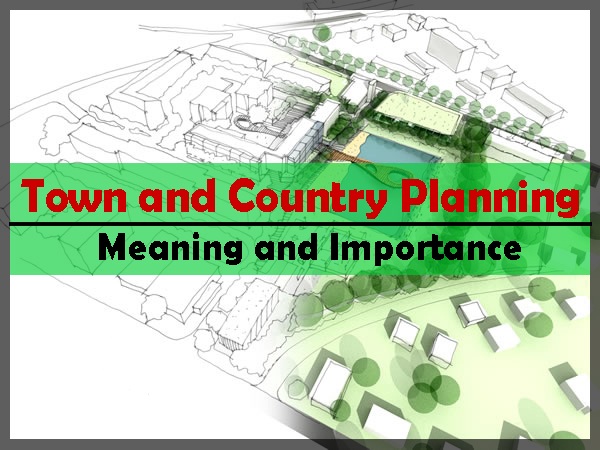Town and Country Planning | Meaning and Importance

- Author: Riya Kapoor
Highlights
Town and Country Planning Organization was set up by Pandit Jawahar Lal Nehru in 1955 to formulate the first master plan for Delhi.
The growth of urban population in India soared up from 17.6 percent in 1955 to 32.4 percent in 2016! The Town and Country Planning Organization (TCPO) has been contributing to this remarkable transfer of people from rural to urban cities since 20 years
TCPO aimed at balancing the urban growth by dispersing the population in smaller urban centers
Also called Urban Development, Town and Country Planning involves formulating master plans for the development of cities. Town and Country Planning Organization was set up by Pandit Jawahar Lal Nehru in 1955 to formulate the first master plan for Delhi. Instruments of Urban Planning such as progressive land policy, functional land use, zoning regulations, etc. have been working in collaboration for the growth and development of cities, considering the social, cultural, economic, political, ecological and physical factors of the population. The government spends hundreds of crores for the planning and development of towns. Let’s have a look at how this has transformed our country.
First Five Year Plan (1951-56)was initiated owing to a substantial increase in urban population during World War 2 mainly for housing and rehabilitation of refugees from Pakistan. As a result, a number of rehabilitation towns and colonies were set up in cities like Delhi, Bombay, Ahmedabad, Uttar Pradesh, Haryana, Punjab, and Calcutta. It was the same period when the city of Chandigarh was created which came to be known as “the modern India”. Second Five Year Plan (1956-61) introduced the concept of Regional Planning and emphasized the importance of master plans.It called for the construction of Housing for low-income groups. This gave rise to Town and Country Planning legislation and institutions were set up for the preparation of master plans in different states.
The following developments since the establishment of Town and Country Planning Authority must be noted.
1. Urban Population:
The growth of urban population in India soared up from 17.6 percent in 1955 to 32.4 percent in 2016! The Town and Country Planning Organization (TCPO) has been contributing to this remarkable transfer of people from rural to urban cities since 20 years. It is forecasted that by 2030, one-third of the population would be living in urban areas. For a fact, India today has the second largest urban population in the world.
2. Prevention of Growth of Slums:
Local Authorities were strengthened to efficiently enforce the implication of building codes and municipal by-laws. As a result, slums in various cities were cleared and people were rehabilitated, increasing the urban population further.
3. Master Plans
Authorities such as Delhi Development Authority (DDA), Mumbai Metropolitan Regional Development Authority (MMRDA) and Madras Metropolitan Development Authority (MMDA) were set up in order to create and implement master plans. These Master Plans featured designing of land use with future perspective, decent housing for everyone, modernized Central Business District, efficient highway and transportation systems and adequate community facilities with residential areas divided into the neighborhood. This concept defeated the traditional mixed-land use norm prevailing in India. Huge amounts were invested in the development of cities like Gandhinagar in Gujrat and Bhuvaneshwar in Orissa.
4. Balanced Urban Growth:
TCPO aimed at balancing the urban growth by dispersing the population in smaller urban centers. This was done to prevent the concentration of population in metropolitan cities like Delhi, Bombay, Calcutta, and Madras. This led to the establishment of Housing and Urban Development Corporation (HUDCO) in 1970 to provide loans to Urban Development Authorities and State Housing Boards, for housing and development projects.
5. Controlled Land Prices:
Priority was given to the development of cities with the population ranging between 50,000-3,00,000, according to the Task Force. Besides, the sites and services scheme for making serviced land available to the poor was launched. Amidst all these developments, the land prices were spiraling. To control this, measures like differential taxation on land, higher taxes on vacant lands, conversion taxes on change of land use and increased stamp duty on transfer of lands were introduced.
6. Equitable Distribution
Urban Land (Ceiling and Regulation) Act, 1976 was introduced to prevent the urban land to be concentrated in the hands of a few. This ensured equitable distribution of land among all social classes. The ceiling was fixed on the possession of urban lands in areas like Mumbai and Delhi.
7. Catering to Small towns:
The scheme of Integrated Development of Small and Medium Towns was launched with the objective of promoting development in towns with a population less than 1,00,000, by providing infrastructural and basic services. This further led to small scale employment, water supply schemes, drainage and sanitation facilities, medical facilities, parks, and playgrounds, etc. in 231 towns.
To summarize, we have enough contribution of urban planning in the development of big and small cities. Although there are several loopholes in the system owing to the rules and regulations, yet this significant contribution overpowers the drawbacks. India would never have entered the flight of modernization, had the town and country planning and development not taken place. I hope you got a clear picture of the importance and contribution of town and country planning, through this article.
More Articles
- Online Listing Tips for Real Estate Agents
- How to start a Real Estate business in India - a complete guide !
- Renting Vs Buying property - How will you decide?
- What you should do in Property Management services
- Home Loan Insurance
- How to choose your builder?
- How to ensure fire safety in your home!
- Tips To Keep In Mind While Taking A Home On Rent
- Importance of Home Security
- How to plan your property budget?
- Leased vs. Purchased vs. Co-Working Office Spaces
- Easy Tips to Build an Eco Friendly Home
- Sample Flat - A Trick by a Builder?
- How to have a Beautiful Guest Room? Impress your Guests with these Guest Room Ideas..
- Understanding MCLR and its Effects on Home Loans
- 5 simple ways to close a real estate deal
- Is it worth to buy property near an airport ?
- Home loan tax benefit
- How to be successful in business as an introvert
- Cost effective home decor ideas
- What to Be-Paying Guest or a Tenant??
- Complete guide to start your small business
- Sports township- New trend in India
- Online Listing Tips for Real Estate Agents
- Understanding Floor Area Ratio- FAR
- Town and Country Planning | Meaning and Importance
- Checklist of Important Property Documents- All You Need to Know
- Role of CREDAI in real estate
Copyright © 2024 RERA Filing. All rights reserved.
 Rera
Act
Rera
Act
 Maharashtra
Maharashtra Karnataka
Karnataka Telangana
Telangana Andhra Pradesh
Andhra Pradesh Delhi
Delhi Uttar Pradesh
Uttar Pradesh Haryana
Haryana Gujarat
Gujarat Bihar
Bihar